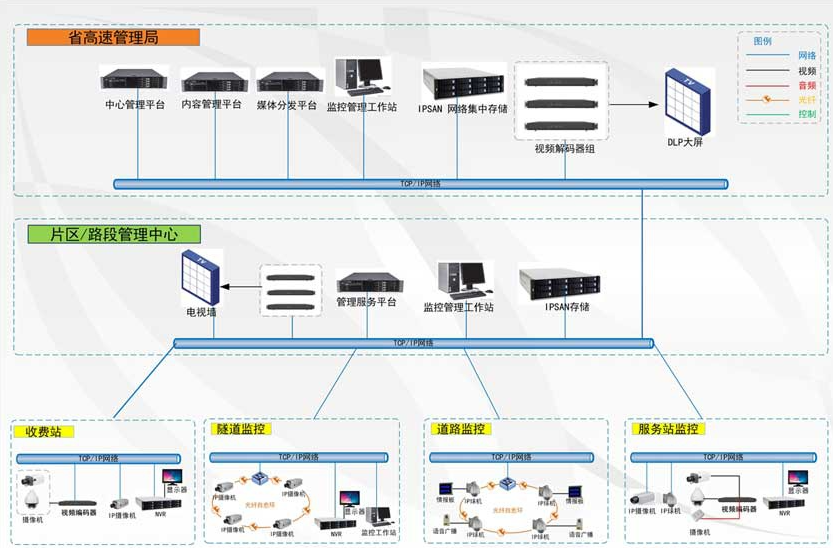Highway Video Surveillance Networking Solution
Demand Analysis
With the rapid development of the economy, the use of highways is getting higher and higher, highways have the characteristics of fully enclosed, full interchanges, fast speeds, etc., the traditional manual patrol method is prone to cause blind spots and lagging response, and a variety of complexities on the highway are also constantly appearing, and the means and methods of crime are also gradually becoming more diversified, violent, and intelligent, and behaviours such as illegally occupying the rescue lanes for driving are also lacking in real-time understanding and The direct evidence of punishment afterwards.
Now many provinces and cities high-speed video surveillance signal only to the toll station and road monitoring sub-centre, did not realize the upward networking, in the event of an accident, the leadership can not remote command, so the need for video signal networking and unified management, due to the dispersal of equipment layout, the need for the entire network of equipment into the operation of a unified monitoring in order to troubleshooting in a timely manner.
With the high-speed video surveillance construction surface and the construction of full coverage of the road section, the number of cameras is geometric growth, video surveillance data, long-term storage, early warning analysis, big data management, situational assessment of urgent needs.
Programme Overview
Intelligent high-speed video surveillance networking system basic model according to the three-star architecture design, set up: road monitoring point, road monitoring sub-centre, monitoring the total centre, the program adopts a fully digital, network transmission scheme, road monitoring point in the high-speed road extension deployment of ultra-low-light cameras, monitoring point is responsible for the signal acquisition, compression, network transmission; road monitoring sub-centre to support the jurisdiction of the monitoring, control, centralized storage, video wall output The monitoring centre supports real-time images of any monitoring point in each high-speed road section at any time, to understand the vehicle driving situation and road environment, to support remote control of the cloud mirror, remote command, and to support the integration of interfaces with other auxiliary systems, such as GIS, GPS, so as to make the system smarter and more efficient.
System features
Integration with face recognition and licence plate recognition algorithms to improve video surveillance intelligence
Docking with systems such as super control to achieve in-depth expansion of functions
Support up to 1080P HD resolution images
Supports IPSAN-based mass storage, Raid0, 1, 5, 10, 50, 6, dual controllers, dual redundant power supply to ensure the security of video data.
Support data integration with GIS system, licence plate management system, online fugitive system, GPS system, etc;
Support optical fibre ring network technology;
Supporting dual code stream technology, signalling control and media stream exchange and sharing technology;
Monitoring centres at all levels can monitor each high-speed road section in real time, playback and backup video files remotely, two-way voice intercom, and control front-end cameras remotely;
System topology

Function Overview
High-speed video surveillance networking management platform, which can achieve unified configuration, maintenance and management of equipment, user hierarchical management, video code stream calling, low bit rate video storage, network video distribution and digital soft matrix and other functions.
Video remote calling and distribution. Support multiple terminals on the network to monitor the same video stream at the same time, that is, many users or terminals on the network (decoding matrix, workstations, video storage terminals) to monitor or accept images from the same encoder at the same time, sharing the same video data stream, without increasing the data traffic on the network.
Soft Matrix Video Scheduling
Manual video switching allows users to schedule any video source within the system to any display terminal (hardware decoding device/software decoding device);
Rotation function, by specifying multiple video sources in a display terminal automatically rotate switching, the administrator can specify any combination of video sources and rotation interval
Alarm information linkage and processing
When an abnormal event occurs, automatically control the camera to adjust to the preset position, or automatically switch the alarm end camera image to the designated monitor display, and at the same time to achieve automatic recording, writing system logs, sound and light alarms and other operations.
Storage policy configuration and storage server control
Manual storage: real-time recording according to demand, and can stop recording at any time.
Alarm linkage storage: you can specify any alarm information to trigger the recording of the specified video source.
Specified timed segment storage: you can specify the timed recording strategy for a video source, configure the time period of timed recording, and can choose to repeat the option according to daily, weekly, monthly, etc.
User Management
System maintenance management module in the system startup, to provide operator handover, system lock screen, system unlocking
Log Management
Record all the system equipment and operators to enter, exit the system time and operation, system failure logs, classification of the alarm log.
Speeding Alarm
When vehicles are captured, real-time monitoring of the speed of moving vehicles, when the vehicle speed is found to be greater than the set speed limit value, the data will be automatically entered into the speeding vehicle information table, and to remind the management personnel of speeding vehicles.
Arming control management
The system can set up the arming conditions such as number plate number, number plate colour, arming time and other information on the central management server; when the vehicle meeting the arming conditions passes through, it will automatically send out an audible alarm or a voice alarm, or send out an alarm command through the communication port to link up the LED display, siren, and other alarm indication equipment, and record the alarm category in the data record.
Remote centralised control
Authorised users on the network computer in the management centre can remotely control the front-end equipment through the network to complete the modification of equipment parameters, change the virtual coil settings and other operations, without the need to run to the intersection for each modification to operate, convenient maintenance.
